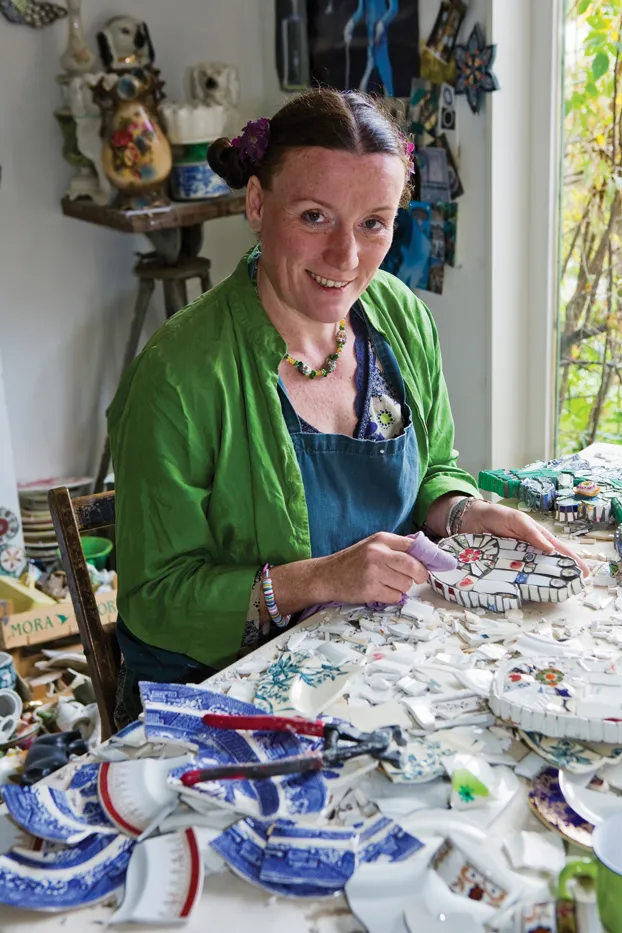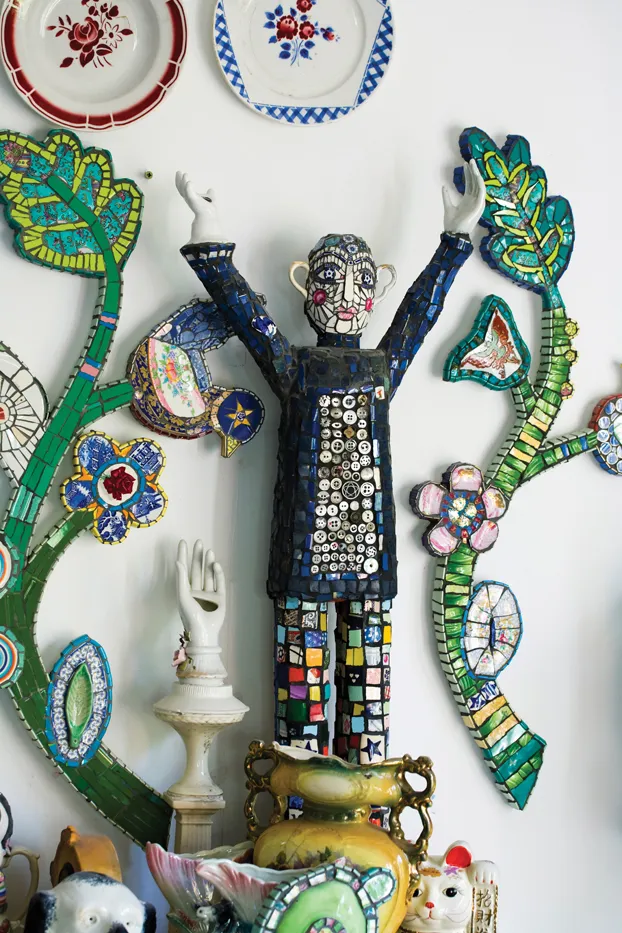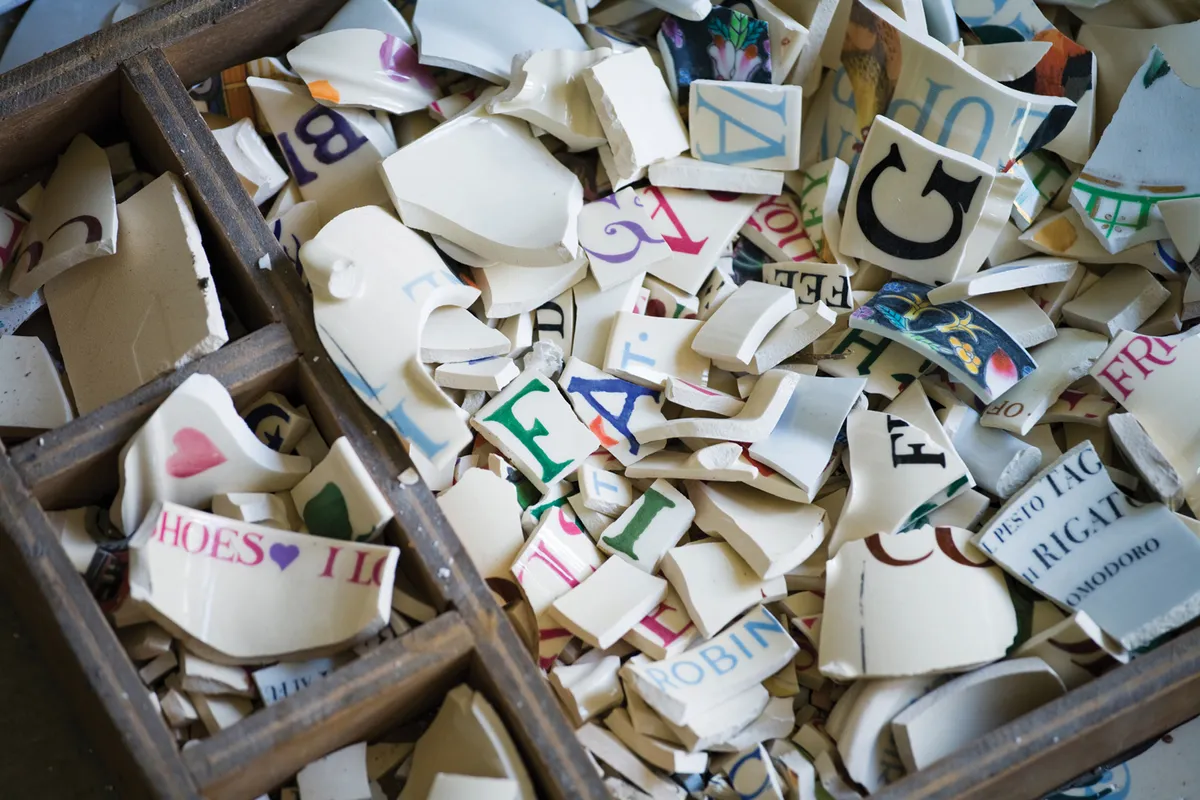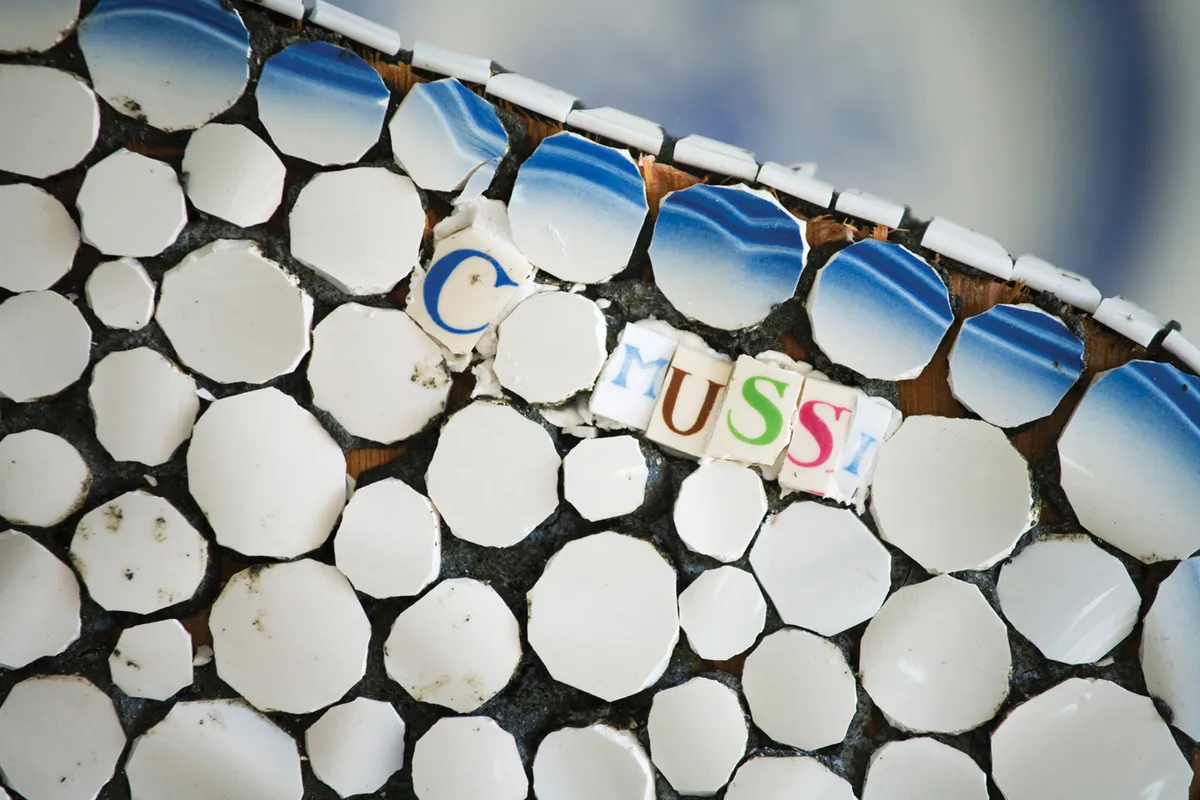'I’ve no idea how to describe what I do,’ laughs Cleo Mussi from her light, bright garden studio in Stroud, Gloucestershire. ‘It’s difficult… if I say I make mosaic, people have images of all sorts of hideous things, but if I say I deconstruct and reconstruct ceramics, that’s a bit pompous. I usually end up just showing people my work.’

What she shows is this: exquisite mosaiced 3D figures or stand-alone pieces – hands, feet, faces, surreal, flowering branches or whole, life-size characters, which are at once whimsical and symbolic. From a distance they are striking and bold, but look closer and you’ll find their overall coherence is in fact the result of hundreds of tiny pieces of crockery, all painstakingly clipped to size and shape and grouted into place. Cup handles form shapely ears, Chinese-style bridges and pagodas become the petals of a flower; floral prints are transformed into cheeks, while makers’ marks and factory stamps might form a watch, an anklebone or a knuckle. Having initially studied Textiles at Goldsmiths College in London in the Eighties, Cleo gradually transferred her ideas to broken china.
‘I was working with recycled fabric and it seemed to make sense to experiment with recycled china too,’ she says. ‘I liked the fact that mosaic was a more permanent material.’ Her first major exhibition, alongside many more-established makers at the Royal Festival Hall in 1991, was a sell-out and since then she has built up a reputation, and a keen following, as one of the country’s most respected mosaic artists. Her cheerful, colourful and optimistic style, often inspired by art history or other cultures – Indian miniatures, the Mexican Day of the Dead – has earned her several high-profile commissions in British hospitals, while shoppers at the top of the escalators of the Solihull branch of John Lewis can feast their eyes on a jaunty scene of children and a dog gambolling through the countryside.

Though her work is modern, much of the raw material is old, bought from a couple of ladies who scour local auction houses for their Stroud market stall. ‘I buy anything that’s broken or that they can’t sell,’ says Cleo, who admits to finding it impossible to walk past a charity or antique shop without a quick peek inside. ‘It gives me a really good, varied supply.’ Her other main supplier is the Bridgewater factory in Stoke. ‘They’ve been brilliant,’ she says. ‘I got to know them when they opened their first shop in Fulham and they’ve been supplying me with broken china ever since. There are some very iconic designs – dots, stars and hearts – which give my work a more modern edge.’
Pieces of plate

It’s this mix of old and new and the associations it triggers that makes Cleo’s work so appealing. ‘I like the fact that within the work you have the whole of our ceramic history. There are bits made here, pieces from China, references to travel and commerce and bringing back fashionable influences and then all that knowledge of how to make glazes and patterns and how to cast things, most of which is now lost… there’s so much information in each piece.’
Equally important are the personal histories that each individual fragment of china carries with it. ‘People look at a shard and it reminds them of their grannies or aunties and things they grew up with. At one of my shows, one chap burst out laughing because one of the big figures had breasts made out of a dinner service that he used to eat his breakfast off,’ she chuckles.

A typical working day for Cleo starts with a swim in the local pool and a quick blitz of emails and orders on the computer. By 10.30 she’s in her studio clipping away. All around her are bits of ceramic awaiting reinvention – Aynsley china, Royal Albert conches, Furnivals’ ‘Denmark’ pattern plates, carefully collected, assorted ceramic vegetables for a forthcoming show on livestock and farming, and an old wooden tray bursting with the clipped letters and words that are a signature feature in her work. Behind her battered desk are row upon row of colourful plates, there for inspiration, for now at least… ‘but if the right idea came up I would use them,’ she says.
‘I love 1950s’, 60s’ and early 70s’ ceramics,’ says Cleo, who is particularly fond of Kathie Winkle’s colourful designs for Broadhurst. ‘Seventies’ pieces are perfect for breaking – they don’t shatter or ‘crinkly crumble’, as some of the older pieces do, they have a really nice sharp cut.’ Midwinter is another favourite: ‘when I started you could pick that up for nothing – not any more,’ she smiles.
Indeed, as time has gone on, Cleo has developed a feel for what is rare or valuable. ‘Although I’m sure I’ve smashed up a few good pieces in my time, most of the stuff I use isn’t fashionable, and I love that I can reinvent it,’ she says. What excites Cleo most is the almost inexhaustible variety of ceramics available – which also means that every piece she makes is different. ‘You have the most amazing finds some days,’ she says. ‘I once found an extraordinary tureen with little artichokes for handles, which I used for the breasts of an earth goddess. That doesn’t happen twice.’

Cracking up
This sense of humour – and inherent positivity - characterises much of Cleo’s work, even though many of her pieces deal with serious themes – love, death, nature, faith, even stem-cell research. One of her latest ranges, ‘Mutants’ – strange, half-funny, half-scary, animalistic figures – is a case in point. ‘Quite a while ago, I’d stuck a pair of duck legs on a ceramic 1950s’ pineapple. I wasn’t sure why, or what it meant, but then you begin to hear about scientists taking cells out of snowdrops and putting them into tomatoes so they don’t freeze, or putting fluorescent jellyfish cells into pigs so they glow – and it begins to make sense.’
Colour is another preoccupation of Cleo’s, as her green-painted studio, vivid clothing and beautifully planted garden show. ‘Unfortunately, most china tends to be blue or white, which is quite limiting,’ she says. ‘You can find touches of pink and green, and reds, oranges and browns came in the 1970s but flesh tones, in particular, are hard to find. I tend to think of my figures as toneless rather than “white”.’
It’s no surprise then that a Green Man character she’s currently working on is posing something of a problem. ‘I want him to be a blend of folklore, English farmers of the 1800s, the American Midwest, and a bit of a new-age Romantic,’ she says. ‘But at the moment I haven’t really thought about any of that – I’m just trying to find the right shade of green. I don’t want him to look ill!’

COLLECTING CLEO
Roadshow expert Mark Allum on the appeal of Cleo’s work
‘I think Cleo’s work is extremely interesting – it borrows from such an ancient tradition but gives it a modern twist. There are references to everything from Byzantine art to contemporary style, and her work is challenging, edgy and original. She’s appreciated now, but I feel that in years to come she will become more and more well known.’
Miranda Leonard, freelance craft curator, agrees: ‘Apart from being beautiful, Cleo’s mosaics are often thought-provoking, even subversive, and this originality adds to their collectability. They are artworks for our decade and are highly prized by not only craft but also art collectors. The larger pieces in particular show incredible mastery of technique and are reasonably priced for such major works, while her smaller pieces – hands, mirrors and bouquets – are popular, too, because people can always find room for them in a domestic setting.’
Cleo's work is stocked at Contemporary Applied Arts in London (020 7436 2344) and Brewery Arts in Cirencester (01285 657181)
FEATURE: Natasha Goodfellow
PHOTOGRAPHS: Mark Bolton
